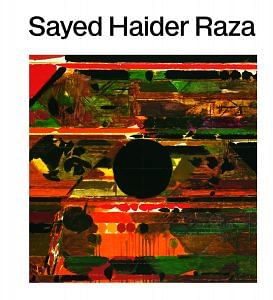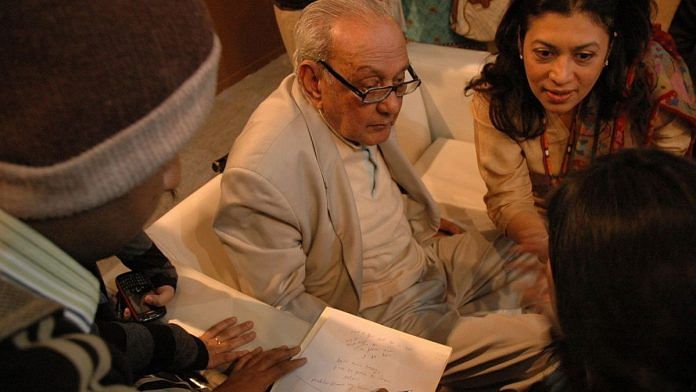In the 1980s, Raza’s love for poetry became an aesthetic element in his paintings. He is perhaps the only modern artist in India, in the world even, who has inscribed in nearly a hundred canvases lines and words of Sanskrit, Hindi and Urdu poetry in Devanagari script. Most of his canvases from the 1980s have titles in Hindi. The poets he drew from included the creators of Upnishads, Kabir, Tulsi, Sur, Mahadevi Verma, Agyeya, Muktibodh, Faiz, and Sahir Ludhiyanvi. Even though Raza’s gaze was fixed on eternity, history seeped in through these poems, a reinvention of some of the Indian miniature painting conventions. His paintings could be gainfully read as love letters to the world, as prayers for grace. While there are works that express agitation and fury, largely, Raza chose peace, tranquillity, resonance and silence as the leading motifs or emotions that his art would evoke.
Widely acknowledged as a master colourist, Raza realized, during his numerous visits to India from France, “that colour was the essence of my work. I wanted to create a musical harmony in colour: colour as density, as expression, as a state of emotion, as sentiments, as time.” In his Itinèraire (Itinerary), he concludes, “But whether it is literature, music, painting, one always comes back to life, to the daily life in the most ordinary things, and it is ultimately always nature which is the culmination point.” Elsewhere, Raza noted: “The essence of art is to show as to lead to reflection, with time or despite time, the authentic artist remains in perpetual search for truth. He always burns with the same fervour, the same passion to the end.” A half-done canvas remains on the easel as he left it in early 2016, before he fell terminally ill, in his Delhi studio. The Raza Foundation has kept it as it was, naming it “The Last Studio.”
Raza spent a part of his childhood near the Narmada, one of the seven holy rivers of India deemed to be holy in the popular imagination. Unlike other holy rivers, Narmada has sacred spaces, temples and shrines on both the banks and, therefore, it is called “ubhaya-tut-teertha” the one with holy places on both sides. In a manner of speaking, Raza, both as a man and an artist, became a ubhaya-tut-teertha.
Also read: Anil Ambani to Vijay Mallya—How India’s 4 top businessmen lost fortune, fame
A sense of the sacred deeply ingrained in his creative psyche, Raza had the twin emotions of beauty and fear, both emanating from nature. He articulated an Indian sensibility combined with a plastic sense of France. He explored both fury and tranquillity, the physical and the metaphysical, the sensuous and the spiritual. While his art was meticulously constructive, he addressed chaos as well. His paintings have rhythmic almost musical structure, with an overarching poetic vision. He was a Parisian modern who reinvented the colourscape from India’s miniature tradition. In his life and art, Raza brought France to India and, by the same token, took India to France. He was by faith a Muslim whose art, especially in the later phase, was deeply rooted in Hindu metaphysics. In his case, they were complementary, not binaries.
Before he began a painting, Raza, whether in Paris, Gorbio or finally in Delhi, would offer a prayer. To quote him, “My studio work starts with a prayer. It is not asking for anything… It begets blessings or grace… I have a conviction that you cannot create art without the support of divine powers… Without doubt, intelligence, reason and the divine energy residing on the top of restrained fury, the inner flame, alone are the best means of artistic action.”
Raza’s art was neither religious nor ritualistic. It was spiritual in that it evoked, embodied and explored the sacred. Surrounded by many bronze statues of Ganesh, a round stone Shaligram, a Jain miniature, a copy of the Quran, Gandhi’s book on Gita, a wooden statue of an erotic Yakshi. Raza, in his Paris studio, revealed the multiple sources of his spiritual inspiration, which had also become his artistic inspiration. Islam, Hinduism and Christianity all contributed towards his deep and abiding sense of the sacred. He aspired for purity, rooted in the essence, inviolate. Though a product of history as everybody else and pursuing many concerns that history imposed on those who grew up in post-war France, Raza tried to supersede history to reach out to an eternity where the vast cosmos was apprehended in its complex but translucent originality on a small canvas, in shapes and colours that had an almost primaeval ethos. It is as if the first Vedic man was viewing existence and the earth, the sun, the world at large come to light. It was a journey back to the beginning.
If prayer is the way one connects, across time and space, with the larger cosmic existence and creates a space of communication, then Raza’s works can be seen as prayers. They are prayers luminous with colours, which yield light both to viewers and to themselves; they are self-illuminated compositions. The Tibetans have a custom of hanging their prayers in the monastery, written on flags or pieces of cloth. Raza painted his prayers as Beej, Ankuran, Purush Prakriti, Suryanamaskar, Kundalini, Bindu-Naad, and so on. They are works “suddenly set ablaze” and having an “‘infinite” direction. However, there is nothing casual or arbitrary about these paintings. With his French “le sens plastique” alive and active, both in his mind and on his canvases, Raza composed works meticulously and painstakingly. The geometrical shapes, the colour combination, the tones and nuances all are balanced in harmony. There is precision: more is less. No excess, no inadequacy. The colours have a choral existence: they supplement, intensify, talk to each other.
Also read: The Taj Hotel: Jamsetji Tata’s love letter to his hometown
Raza was an artist of evocations and resonances. He invariably evoked a state of mind, an aspect of pure consciousness. He made silence and depth speak, perhaps whisper gently. There were no human figures except in his early works. Figures were seen as shapes—triangles, circles, squares. They constituted the elemental geometry. If the whole universe was constituted out of five elements, “panchatatvas,” as the traditional Indian belief asserts, the shapes were the tattvas, the elements of figures. The sacred had no figure, only shape and colours. The pure existed in essence.
Raza painted many works with the same title—La Terre, La Nuit, etc. They don’t replicate each other; they resemble each other superficially but differ so vastly that each one of them is truly unique. In Indian classical music, a raga is performed many a time, and each time, the same Raga is new and fresh, with elements of mood, sensitivity, imagination incorporated and accentuated in different and sometimes unexpected ways. Raza was a similar musician of abstraction. Singularly concentrated, the sacred is plural in Raza’s art. These works are luminous, drenched in grace, and they make us see what we may otherwise not come across: the painted surface as a constructed space of prayer, an illuminating residence of the sacred.

This is an excerpt from In the Hundredth Year by Ashok Vajpeyi in Sayed Haider Raza, edited by Ashok Vajpeyi, published by Mapin Publishing, Ahmedabad, in association with The Raza Foundation, New Delhi.



